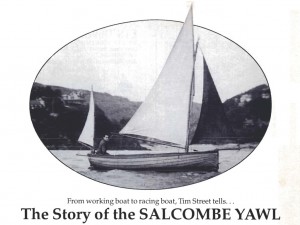THE SALCOMBE YAWL
The Salcombe Yawl has a history which goes back at least 200 years to the straight-stemmed, transom-sterned, yawl rigged local fishing vessels of the late 18th-early 19th century. Certainly the earliest print of Alston House above Widegates on the Salcombe estuary, shows such a small gaffed rigged yawl. This print is dated 1806, but further evidence is shown by the depiction of a very similar vessel in the lovely print of 1823 by W Daniell ARA, giving a view of the Grange and old Cliff House, Salcombe. This is one of a series that were done of the English coast in that and the following years. Thus, by 1823, it is clear that the yawl-rigged fishing-boat, had become established as a common type on the South Devon coast.
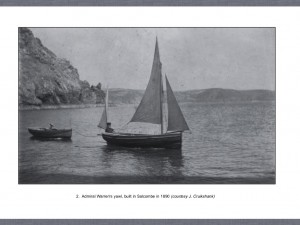
The coast creates short steep seas, on top of the long rollers sweeping in from the Atlantic and up the Channel to Bolt Head and the Start. The most suitable boats which evolved had to be able to sail to windward out of the Salcombe estuary against a strong tide and to keep to sea, anything up to 10 miles off the coast, to carry out the long-line fishing or lobstering that the local economy required. The straight stem appears to have evolved to ease the building and to cut through the short seas. A broad stern and good sea keeping was also required for fishing with long lines and the stumpy gaff yawl rig was needed to enable the boat to sail out of Salcombe estuary against the tide, before taking off the mainsail and operating easily under jib and mizzen with only one man, or a man and a boy on board.
By 1853, when the earliest painting, now in the Salcombe Yacht Club, was made, the Yawl is clearly visible as the direct ancestor of the Salcombe Yawl of today as she is similar in all respects. Also about 1853, we hear of the first occasion when Salcombe yawls, then known as the Licensed Watermen’s Boats class, raced together in the Salcombe Regatta. These work-boats were yawl rigged and open or quarter decked. They were between 14 ft and 18 ft long and were all owned and worked out of Salcombe, being used for fishing and as hire boats for picnic parties.
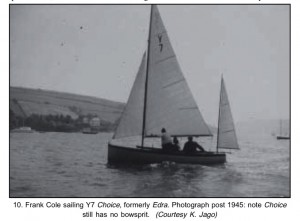
There was one Regatta every year with usually two races for each class. There is no record of winning boats and it is believed that the first actual records, which appear to have been lost, dated from 1906 although at one time there were earlier postcards in Overbecks Museum.
In 1907 there first appears a record of a ‘Class for Yawls not exceeding 15ft 6ins’. A class of four boats raced during the season with the winner being ‘ Handy Andy’ Mr. Giles; second ‘Lurline’ Mr. Cyril Turner the SYC Hon. Secretary; third ‘Cynthia’ Mr. W. Patey; and fourth ‘Frances’ Mr. W. Johnson. The sailing Committee met two days before a race to determine the conditions and entries had to be with the Hon. Secretary by 10.30 am. on the day of the race, when the sailing instructions were issued.
In 1908 the class was changed to the ‘16ft. Class’ and five yawls took part with ‘Lurline’ Mr. Turner winning overall, ‘Lillie’ Mr. W. Patey, second and ‘Falcon’ Mr. J.N. Rodick, third. ‘Pickle’ Mr. Mawson and ‘Still Waters’ Miss Herbert, completing the fleet.
Sometime around 1906 Captain A. Street, an Army Officer, had the Yawl ‘Busy Bee’ built by Dornom’s Boatyard and Andrew McIlwraith had the ‘Foam’ built. It is believed that these two boats were amongst the first yawls built specifically for pleasure sailing, although the first appearance of ‘Busy Bee’ in the SYC racing records was not until 1911.
‘Busy Bee’ was 15 ft 6 in long, half-decked with a centreboard, bowsprit, gaff-rigged mainsail and sprit rigged mizzen. Although soundly built, she lasted until 1963, she was recorded as coming last in almost every race of the 1911 Salcombe Yacht Club summer series. Although she raced occasionally up until 1914, she was no match for the Licensed Watermen’s boats and an engine was installed in 1922. ‘Foam’, which is 17ft. 6” long, did not race with the 16ft or 15ft. 6 ins. class Yawls but usually won in the large class. Under various rigs including a tall Bermudan rig, she raced with the Salcombe ‘A’ Class as A 4 and later as A 12, up until at least the early fifties and is still in existence, once again rigged as a yawl.
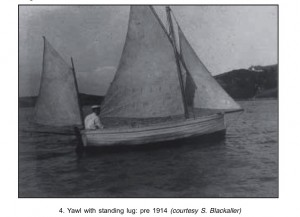
Racing stopped during the First World War and only re-started in 1919 when a small class of four yawl-rigged boats raced together during the season as the ‘Under 16ft. Class’ on a handicap basis. They were various lengths from 14 ft to 15 ft 6 in, and were handicapped according to length. Their names were ‘Evelyn’ (named after Miss Evelyn Pepperell), ‘Carew’, Helena’ and ‘May’.
In 1917, the boat was built which really started the Yawl Class as a racing class. Jim Stone (then aged 16), at that time working as a shipwright with Edgar Cove and living at East Portlemouth on the Salcombe estuary, built himself a 14 ft Yawl in a garden shed owned by a Lieutenant Wilcox and named her ‘Blackbird’, later numbered Y 2. As he had no paint she was creosoted. For several years after the war, he won every race in her and later, when sailed by either his brother Terry or his son Alec Stone, she continued winning up until 1937. Sadly, she was lost in a storm off Whitestrand in the late 1940s.
The ‘Under 16ft. handicap and yawl class’, now consisting of privately owned boats totalling up to ten in number, raced on a fairly regular basis until 1935, by when they were called ‘Class D, Yawls up to 15ft. 6 ins’, although rarely more than six turned out. They included those named above together with Y 3 Evelyn, Y 4 Blonde, Y5 My Lady Joan and Y 5 Elaine, and Y 6 Penelope. Other boats, such as ‘Beccasine’, ‘ Sea Lass’, ‘Rose’, ‘Blue Bird’ ‘Handy Andy’, ‘Frances’, ‘Globe’, ‘Lady Jane’ and Y 5 ‘Shag’, yawls of differing lengths, also raced with them. By then they had been mostly standardised on a 16 ft length, although some were still 15ft 6” long and they raced on a handicap basis. Although several were still completely open, by this time most were three-quarter decked. They were all straight stemmed and transom stern and were exactly the same in layout and general appearance as the current Yawls. They were mostly built by local yards: Edgar Cove’s, Dornom’s and Chant’s.
Three new boats appeared in 1937, Y 7 ‘Brunette’, owned by R.E. Morris, Y 8 ‘Boy Tom’ and a converted 16ft “B” Class, Y 9 ‘Priscilla’, formerly the ‘Sunbeam’, owned by and sailed by various Coves.
The next big step came in 1938. Over the preceding winter, three yawls, designed by Mr. Lionel Clayton of Portlemouth, were ordered from Mashfords Yard at Cremyll. These were Y 11 ‘Edra’, R.E. Morris of Batson; Y 12 ‘Becas’, Col G. de C. Glover and Y 13 ‘Seagull’, D.V. Sanders. Captain A. Lindsay Smith also bought a new Yawl from the yard of Morgan Giles at Teignmouth in Devon. Morgan Giles, famous for his Fourteen Foot Internationals and other racing yachts, had designed and built four 16ft. boats for the Teign Corinthian One Design, which, however, were not accepted. Captain Lindsay-Smith bought one of these boats, had a 250 lb iron keel and heavy iron centre-board installed and named her ‘Auburn’. She was numbered Y 15 and built out of cedar, with iron fastenings. The same winter, Y 10 ‘Marie Louise’, an open boat, later lost on the rocks under the Moult, was ordered by Miss P. Chase
On the 6th August 1938, Y 15 ‘Auburn’ was launched for her first race, beating Y 9 Priscilla into second place by 35 Minutes. From her first race ‘Auburn’ outclassed all the other yawls then in existence, including the new Mashford’s built yawls, with the result that most of the other, earlier, boats simply stopped racing.
The next week, seven boats took part in the 1938 Regatta, finishing in the following order: Y 15 ‘Auburn’, Y 13 ‘Seagull’, Y 9 ‘Priscilla’, Edgar Cove, Y 11 ‘Edra’ R.E. Morris, Y 2 ‘Blackbird’ Alec Stone, Y 12 ‘Becas’ Col. Glover and Y 10 ‘Marie Louise’ Miss P. Chase. The Auburn Cup was also first presented that year and was won by ‘Auburn’, sailed for Captain Lindsey-Smith by Lionel Clayton.
To compete the following year, 1939, Jim Stone built a new ‘Blackbird II’ (Y14) out of mahogany on oak frames, at Long Park, East Portlemouth and eight yawls raced. The class was split into two: Yawls (Gunter Rig), in which Penelope, sailed by John Cove (aged 12) beat Y 4 Blonde, sailed by Commander Loftus-Jones, Y 2 Blackbird I and Y 10 Marie Louise and Yawls (Bermuda Rig), in which Y 14 Blackbird II, sailed by Alec Stone (also aged 12), beat Y 15 Captain Lindsay-Smith, Y 12 Becas, Col. Glover and Y 7 Edra. R.E. Morris had bought a second Morgan Giles hull and named her Y 7 ‘Edra’.
During the war Y 15, ‘Auburn’ was taken to West Mersea in Essex, by No. 1 Motor Boat Company RASC, as a tender, and ‘Blackbird’ and ‘Edra’, now re-named ‘Choice’ and owned by Frank Cole, which was given the fishing boat number of 207, were used for fishing and as work boats. After the war, ‘Auburn’ was returned to Captain A. Lindsey-Smith, who had also moved to Essex. After his death, he left her to his yacht’s skipper and she stayed on the River Colne, where she is still believed to be in existence at Brightlingsea.
In 1946 racing re-started and the 16ft Restricted Yawl Class then consisted of Y14 ‘Blackbird II’, Jim Stone; Y7 ‘Choice’, Frank Cole, and Y9 ‘Priscilla’, now regularly sailed by Richard Cove. They were joined occasionally by Y 5 ‘Elaine’, Y 4 ‘Blonde’, Y 12, now named ‘Genesta’ and owned by Brigadier Morton and Y2 ‘Blackbird’, which, however, raced as a separate class for separate prizes.
In 1947 came the first of the post war ‘new’ yawls, Y15 ‘Kingfisher’, which was built by Jim Stone for a Mr R Triscott. Even Terry Stone, who helped build her, is not clear why she was given the same number as ‘Auburn’. She was designed as a direct improvement on ‘Blackbird’ although originally, like both ‘Choice’ and ‘Auburn’, she had no bowsprit. However during 1947 ‘Choice’ was fitted with a bowsprit to give her better balance and later, after the death of Mr Frank Cole, was purchased by Richard Cove, after ‘Priscilla’ was banned from racing at the end of the 1948 season, for being undecked. It is interest to note that, although ‘Priscilla’ remained gaff rigged with a sprit rigged mizzen, when sailed by Richard Cove, she still won the Championship in 1947 and 1948, with ‘Blackbird’ second, ‘Choice’ third and ‘Kingfisher ‘ fourth.
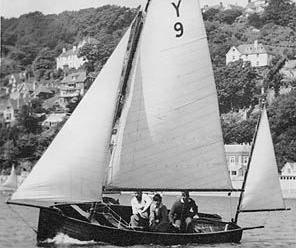
In 1948, these four were joined by Y 16 ‘Ariel’, owned by Mr W H Thorning, usually with Harris Thorning as his crew and the yawls then raced in two classes. The Old Yawls consisted of Y 5 ‘Elaine’, sailed by Ralph Pepperell who only died very recently, ‘Sea Maid’, Mr Roly Tyler and Y 12 ‘Genesta’, Brigadier Morton. The season point’s series was won by ‘Priscilla’. Second was ‘Blackbird’, third Y 7 ‘Choice’, Frank Cole, fourth Y 15 ‘Kingfisher’ and fifth Y 16 ‘Ariel’, sailed by B. Thorning.
In 1949, ‘Priscilla’ was banned for being undecked and not having an iron keel, so the class virtually died out. ‘Choice’ and occasionally ‘Blonde’ raced in the Handicap Class up until the Salcombe Regatta, when they were joined by ‘Blackbird’ and ‘Ariel’. ‘Choice’ won the championship that year.
Although as early as 1946, Jim Stone had started building yawls in his small yard above Goodshelter, in East Portlemouth, he was only able to complete a few each year. Even so, up until 1960, only two other boats, Y21 and Y29, were built in another yard, G. D. and N. Winter’s, at Lincombe.
Despite his steady output of lovingly built Salcombe yawls, Y7 ‘Choice’ and Y14 ‘Blackbird’ remained the best two yawls year in year out, in spite of constant improvement and refinements in design, and it was not until 1965, when Y61 ‘Taylormaid’ was built by Peter Taylor, (later the world famous builder of International Finns), as his first attempt at yawl building, that ‘Choice’ and ‘Blackbird’, by then nearly 30 years old, were outclassed.
The building of Y61 led directly to the formation of the Salcombe Yawl Association at the end of 1965, under the presidency of Dr Breach of East Portlemouth. At the inaugural meeting, the following were elected to the opening Committee:- Dr. Breach, Major E.G.M. Pearce, Geoffrey Sutton and Terry Stone, with Norman Mallett as Secretary. Geoffrey Sutton was elected the first Chairman and Major Tim. Street was invited to prepare the first draft of the Class Rules in conjunction with Jim Stone. Subsequently, at the next meeting, they were formally adopted and it was decided to formally name the class the Salcombe Yawls and to keep them as purely traditional, with wooden masts.
‘Taylormaid’ showed that successful yawls could be built by builders other than Jim Stone and several other yards, such as Edward Cove of the old firm of Edgar Cove, Powercraft, David Gibbens, Hughie Cater and Michael Attfield, all small specialist Salcombe boat-builders, started building racing yawls on a regular basis, intended as improvements on ‘Taylormaid’.
‘Taylormaid’ herself was designed as a direct improvement on Y7 ‘Choice’, with the addition of broader buttocks and much straighter and finer lines aft, to improve the downwind and reaching performance. Up until then virtually all Yawl races had been won on upwind performance and running and reaching had been of very minor importance. However, much of her success was also due to the fact that she was substantially lighter than the Jim Stone built boats.
During the Salcombe Town Regatta of 1968, the yawls raced outside the harbour for the first time and, since then have gone from strength to strength. Many of them are now built in Island Street by Michael Attfield, some of the best of which have been designed by the famous America’s Cup designer, Ian Howlett. The Yawls number over 180 and race in regular series in Salcombe as well as in team races, often taking part in away events.
